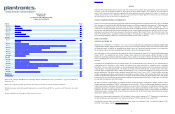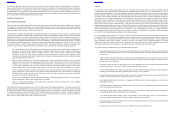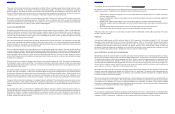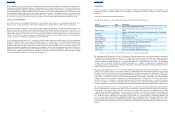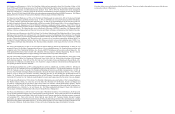Plantronics 2012 Annual Report Download - page 12
Download and view the complete annual report
Please find page 12 of the 2012 Plantronics annual report below. You can navigate through the pages in the report by either clicking on the pages listed below, or by using the keyword search tool below to find specific information within the annual report.
ITEM 1A. RISK FACTORS
Investors in our stock should carefully consider the following risk factors in connection with any investment in our stock. Our
stock price will reflect the performance of our business relative to, among other things, our competition, expectations of securities
analysts or investors, and general economic market conditions and industry conditions. Our business, financial condition and
results of operations could be materially adversely affected if any of the following risks occur. Accordingly, the trading price of
our stock could decline, and investors could lose all or part of their investment.
Adverse or uncertain economic conditions may materially adversely affect the Company.
Global economic concerns such as the recurrence of recession on a regional or global basis have increased uncertainty and
unpredictability for our business and added risk to our future outlook. A global economic downturn, a downturn in the U.S. or a
more severe downturn in Europe, whether short-term or prolonged, could result in reductions in sales of our products, longer sales
cycles, slower adoption of new technologies, increased price competition and customer and supplier bankruptcies.
Financial institutions continue to experience significant market pressure and increasing regulatory scrutiny, most recently in
connection with lenders' exposure to the sovereign debt of countries like Greece, Italy and Spain. As a result of the pressure and
regulatory scrutiny, lenders may be more likely to further consolidate, cease to do business, or be required to meet increased
compulsory capitalization thresholds, any of which could result in a tightening of the credit markets, a low level of liquidity in
many financial markets, and increased volatility in fixed income, credit, currency and equity markets. There could be a number
of negative effects on our business, including impaired credit availability and increased financial instability of our customers,
suppliers and distributors and other sales channel sources. Any of these events could harm our business, results of operations and
financial condition.
Uncertainty regarding future economic conditions also makes it more challenging for us to forecast operating results, make business
decisions, and identify the risks that may affect our business, sources and uses of cash, financial condition and results of operations.
Further, fluctuations in foreign currency exchange rates may impact our revenues and profitability because we report our financial
statements in U.S. Dollars ("USD"), whereas a significant portion of our sales to customers are transacted in other currencies,
particularly the Euro and the Great Britain Pound (“GBP”). We hedge a portion of our Euro and GBP forecasted revenue exposure
for the future twelve month period. We can offer no assurance that such strategies will be effective in minimizing our exposure.
If the Euro and GBP fall against the USD, our revenues, gross profit and profitability in the future could be negatively affected.
See also our risk titled “We are exposed to fluctuations in foreign currency exchange rates which may adversely affect our revenues,
gross profit, and profitability.”
Our operating results are difficult to predict, and fluctuations may cause volatility in the trading price of our common stock.
Given the nature of the markets in which we compete, our revenues and profitability are difficult to predict for many reasons,
including the following:
• Our operating results are highly dependent on the volume and timing of orders received during the quarter. Customers
generally order on an as-needed basis, and we typically do not obtain firm, long-term purchase commitments from
our customers, making forecasting difficult. As a result, our revenues in any quarter depend primarily on orders
booked and shipped in that quarter.
• We incur a large portion of our costs in advance of sales orders because we must plan research and production, order
components and enter into development, incur sales and marketing expenditures, and other operating commitments
prior to obtaining firm commitments from our customers. In the event our inventories for one or more products
exceed demand, the risk of future inventory write-downs increases. Conversely, in the event we have inadequate
inventory to timely meet the demand for particular products, we may miss significant revenue opportunities or incur
significant expenses such as air freight, costs for expediting shipments, and other negative variances in our
manufacturing processes as we attempt to make up for the shortfall. When a significant portion of our revenue is
derived from new products, forecasting appropriate volumes of production is even more difficult.
Fluctuations in our operating results, including the failure to meet our expectations or the expectations of financial analysts, may
cause volatility, including material decreases, in the trading price of our common stock.
Table of Contents
The success of our business depends heavily on our ability to effectively market our UC products, and our business could be
materially adversely affected if markets do not develop as we expect.
We compete in the business market for the sale of our office and contact center products. We believe that our greatest long-term
opportunity for profit growth is in the UC office market, and our foremost strategic objective for this segment is to increase headset
adoption. UC is the integration of voice and video-based communications systems enhanced with software applications and
Internet Protocol (“IP”) networks. It may include the integration or consolidation of devices and media associated with a variety
of business workflows and applications, including e-mail, instant messaging, presence, audio, video and web conferencing, and
unified messaging. UC seeks to provide seamless connectivity and user experience for enterprise workers regardless of their
location and environment, improving overall business efficiency and providing more effective collaboration among an increasingly
distributed workforce. We continue to invest in the development of new products and to enhance existing products to be more
appealing in functionality and design for the UC market. We also target certain vertical segments to increase sales. We continue
to believe that the implementation of UC technologies by large corporations will be a significant long-term driver of enterprise
headset adoption, and, as a result, a key long-term driver of revenue and product growth. However, we can give no assurance that
significant growth in UC will occur or that we will be able to take advantage of any growth that does occur.
Our ability to realize our UC plans and to achieve the financial results projected to arise from UC adoption could be adversely
affected by a number of factors including:
• The risk that, as UC becomes more widely adopted, competitors will offer solutions that will effectively commoditize
our headsets which, in turn, will reduce the sales prices for our headsets.
• Our plans are dependent upon the market success of major platform providers such as Microsoft Corporation, Cisco
Systems, Inc., Avaya, Inc., Alcatel-Lucent, and IBM, and we have limited ability to influence such providers with respect
to the functionality of their platforms, their rate of deployment, and their willingness to integrate their platforms with our
solutions.
• The development of UC solutions is technically complex and this may delay or obstruct our ability to introduce solutions
that are cost effective, feature-rich, stable and attractive to our customers on a timely basis.
• Our development of UC solutions is dependent on our ability to implement and execute new and different processes in
connection with the design, development and manufacturing of complex electronic systems comprised of hardware,
firmware and software that must work in a wide variety of environments and multiple variations, which may in some
instances increase the risk of development delays or errors and require the hiring of new personnel and/or third party
contractors.
• Because UC offerings involve complex integration of hardware and software with UC infrastructure, our sales model
and expertise will need to continue to evolve. If we fail to anticipate or effectively implement changes in our sales model
or channel our selling techniques and efforts at the primary UC decision makers within enterprises, our ability to maintain
and grow our share of the UC market may be adversely impacted.
• As UC becomes more widely adopted we anticipate that competition for market share will increase, and some competitors
may have superior technical and economic resources.
• UC solutions may not be adopted with the breadth and speed in the marketplace that we currently anticipate.
• UC may evolve rapidly and unpredictably and our ability to adapt to those changes and future requirements may impact
our profitability in this market and our overall margins.
Because the major providers of UC software utilize complex and proprietary platforms in which our UC products will be integrated,
it will be necessary for us to expand our technical support capabilities. This expansion will result in additional expenses to hire
and train the personnel and develop the infrastructure necessary to adequately serve our UC customers. Our support expenditures
may substantially increase over time as these platforms evolve and as UC becomes more commonly adopted.
If these investments do not generate incremental revenue, our business could be materially adversely affected.
Table of Contents
1312






